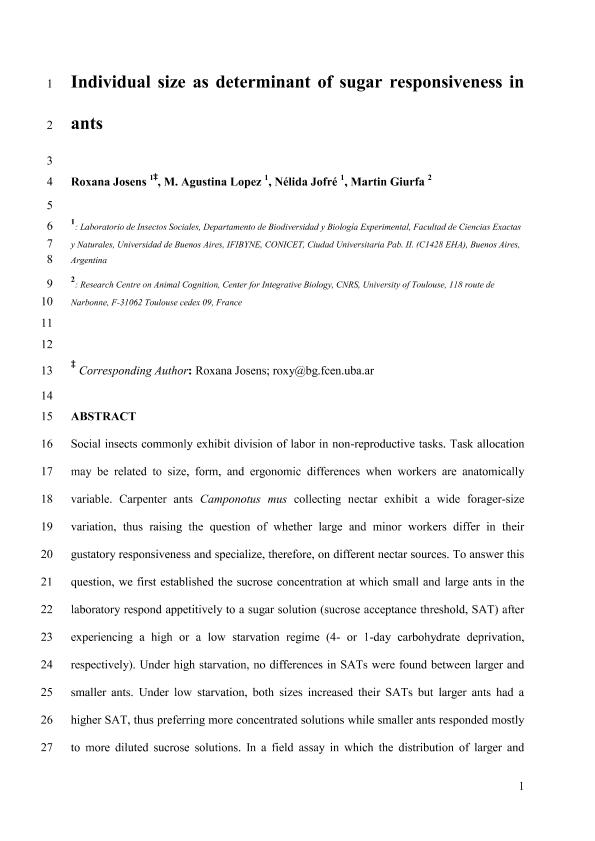Artículo
Individual size as determinant of sugar responsiveness in ants
Fecha de publicación:
10/2018
Editorial:
Springer
Revista:
Behavioral Ecology And Sociobiology
ISSN:
0340-5443
Idioma:
Inglés
Tipo de recurso:
Artículo publicado
Clasificación temática:
Resumen
Abstract: Social insects commonly exhibit division of labor in non-reproductive tasks. Task allocation may be related to size, form, and ergonomic differences when workers are anatomically variable. Carpenter ants Camponotus mus collecting nectar exhibit a wide forager size variation, thus raising the question of whether large and minor workers differ in their gustatory responsiveness and specialize, therefore, on different nectar sources. To answer this question, we first established the sucrose concentration at which small and large ants in the laboratory respond appetitively to a sugar solution (sucrose acceptance threshold, SAT) after experiencing a high or a low starvation regime (4- or 1-day carbohydrate deprivation, respectively). Under high starvation, no differences in SATs were found between larger and smaller ants. Under low starvation, both sizes increased their SATs but larger ants had a higher SAT, thus preferring more concentrated solutions while smaller ants responded mostly to more diluted sucrose solutions. In a field assay in which the distribution of larger and smaller ants on sugary food sources was analyzed, small and medium ants were found—in different proportions—at all food sources while larger ants were only found at nectar sources with a higher sugar flow rate, i.e., providing more sugar per unit time. Both field and laboratory assays supported that sugar-related parameters act as determinants of the size distribution of ants among food sources. In addition, interindividual differences in alternative non-sugar-related variables may contribute to this distribution, leading thereby to a potential nectar foraging specialization. Significance statement: Task specialization is crucial for the ecological success of social insects. Carpenter ants allocate individuals of variable size to foraging, thus raising the question of whether they differ in their food preferences. We determined the sugar concentration at which an appetitive response occurs in small and large carpenter ants, and analyzed their distribution on natural and artificial nectar sources in a field assay. Under low starvation, larger ants responded more than smaller ants to higher sucrose concentrations. Coincidently, in the field assay, they were mainly present at sources with higher sucrose delivery. This kind of specialization may reflect the fact that larger ants have larger feeding apparatuses, which may confer a better capacity to deal with the higher viscosity of more concentrated nectars and allow collecting more food at nectaries with higher sugar flow rates. Size specialization may thus increase colony success in the exploitation of variable food sources.
Palabras clave:
CARPENTER ANTS
,
NECTAR FORAGING
,
SUCROSE THRESHOLD
,
WORKER SIZE
Archivos asociados
Licencia
Identificadores
Colecciones
Articulos(IFIBYNE)
Articulos de INST.DE FISIOL., BIOL.MOLECULAR Y NEUROCIENCIAS
Articulos de INST.DE FISIOL., BIOL.MOLECULAR Y NEUROCIENCIAS
Citación
Josens, Roxana Beatriz; Lopez, M. Agustina; Jofré, Nélida; Giurfa, Martín; Individual size as determinant of sugar responsiveness in ants; Springer; Behavioral Ecology And Sociobiology; 72; 162; 10-2018; 1-9
Compartir
Altmétricas




